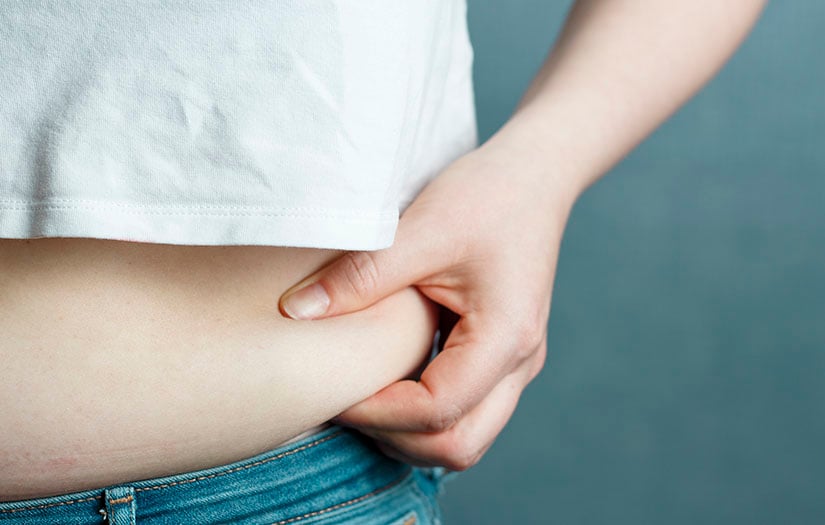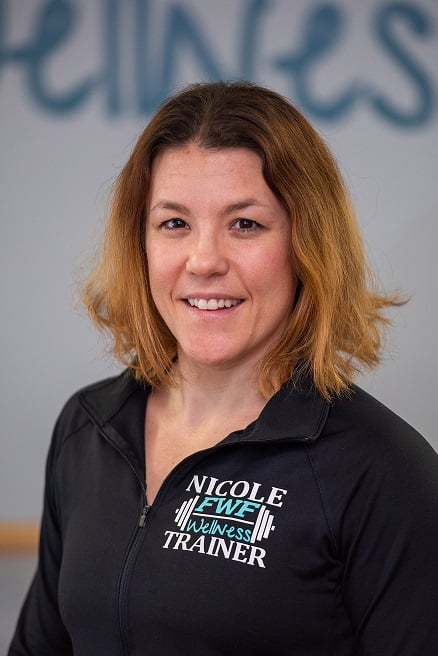Spare tire, breadbasket, muffin top, Jello pudding pack, and love handles are all terms synonymous with abdominal (belly) fat.
“What should I eat to get rid of this muffin top?”
“I heard that XYZ workout program will melt away all of my gut, is that true?” “How do I turn my belly fat into muscle?”
These are all questions that are commonplace in our work as fitness professionals. Many certified personal trainers would agree that they often have clients hire them intending to eliminate belly fat and love handles. Ultimately, it all comes down to the goal of body fat reduction. What is the best evidence-based strategies to achieve fat loss and reduce love handles?
If you want a tool that calculates body fat, follow the link!
What are love handles?
Love handles are simply excess abdominal fat. The term “love handles” mostly refers to subcutaneous fat around the midsection, however, they can be accentuated by excess visceral fat.
Before we get deep into how to reduce love handles, let’s discuss the different types of fat.
Adipose tissue (body fat) serves a variety of functions within the human body. This tissue functions as a storage site for excess energy for later use, and as an endocrine organ producing hormones such as leptin, estrogen, cytokine tumor necrosis factor-alpha (which plays a role in immune function) and resisting (which is thought to play a role in inflammation and insulin resistance). Fat tissue also helps to cushion the organs and serves as insulation for the body (Mittal, 2019).
Adipose tissue is primarily composed of adipocytes, which are cells that grow and shrink depending on how much fat is deposited in them. These cells grow (hypertrophy) in many cases of obesity. The size of adipocytes is controllable with fat loss methods.
However, once an adipocyte reaches a critical mass from a lot of excess energy (i.e., overfeeding for activity level) and the cell can no longer grow, adipocyte proliferation (the formation of new fat cells) will be triggered. In other words, fat cells can grow to a certain mass and that fat gain is reversible, but the creation of new fat cells is permanent (Summerfield, 2016).
There are two different types of fat on the body- visceral fat (stored inside the body between the organs) and subcutaneous fat (stored underneath the skin). Visceral fat, in excess amounts, is considered more dangerous than subcutaneous fat, but on the flip side, it is also more easily removed. (Schleinitz et al., 2014).
Read How to Get a Six Pack for more information on the breakdown of abdominal muscles.
Why do some get love handles and some do not?
Fat storage patterns are determined by factors such as gender, hormonal status, and genetics. Typically, males have a high ratio of visceral fat, and females have a higher ratio of subcutaneous fats.
Additionally, lower body subcutaneous fat deposits (i.e., love handles) are likely to be composed of a higher number of these adipocytes which will make this type of fat much harder to lose than fat stored in the upper body.
Visceral fat is composed more of larger fat cells but lower in number making this fat easier to remove. Women tend to have high numbers of fat cells than men which makes the fat loss a bit more challenging for women (Karastergiou et al., 2012). The bottom line is that fat storage patterns are almost completely controlled by factors outside of diet and exercise.
I have love handles. How do I get rid of them?
It is important to highlight that it is impossible to spot reduced areas of fat on the body because fat storage patterns are not controllable by diet and exercise (Summerfield, 2016). Therefore, an overall fat loss strategy is most effective at reducing or removing love handles.
The human body is a living thing. It is not a computer. Therefore, it will adapt to the stresses and demands placed on it and that includes increased physical activity and dieting. An overall strategy of long-term behavior change strategies is the best weapon against love handles. The following are some strategies that can help.
Fat Loss Strategy #1: Increase your baseline physical activity
The most recommended way to reduce body fat is to expend more energy than is being consumed. One of the easiest ways to begin to increase physical activity can simply be to increase the number of steps you take in a day.
Attending a group fitness class, completing additional house chores, walking/biking to work instead of driving are all ways physical activity can be increased. Commercial step trackers (e.g., Apple Watch, Fitbit, or your phone) can be a great way to estimate current physical activity and to take steps (no pun intended) to increase it (Golden, 2021).
What about cardio?
Cardio exercise (i.e., dance, cycling, running, boot camp classes, etc.) can burn through quite a few calories and help to increase energy expenditure. It is important to combine increased daily step counts with several bouts of moderate (cardio) physical activity to maximize fat loss. It is best to aim for 150-300 minutes per week of cardio to maximize fat loss (Chiang et al., 2019).
Fat Loss Strategy #2: Consume less energy than you expend…and track your data!
While this may seem simple and obvious, it is more complicated than it seems. Many of my clients have a lot of difficulties understanding how many calories they need per day versus how many calories they are consuming. This is most often caused by a misunderstanding of portion sizes and failing to account for small bites of food taken throughout the day. Food scales, food log apps, measuring cups, and measuring spoons can help determine how many calories are being consumed and its effect on body weight as can calorie counting apps.
Measuring your food intake accurately for a week and monitoring body weight several times during this period can give you an idea of how many calories are needed to maintain weight. Simply visually estimating food consumed may not be adequate and may result in a miscalculation of energy consumed. Aim for a deficit between 300 and 500 kcal/day for fat loss that spares muscle tissue. (Archundia Herrera & Chan, 2018).
Fat Loss Strategy #3: Balance your macros
An appropriately balanced diet is important to enhance fat loss while sparing lean body mass as much as possible. Determine how many calories are needed to sustain current weight and plan the appropriate caloric deficit. The first macronutrient to calculate is protein as intake should be adequate to maintain skeletal muscle as much as possible. An intake of 1.2 to 1.6 g/kg/day is recommended for protein (Hj et al., 2015).
Next, figure out the necessary carbohydrates. Carbohydrate intake should range from 45 to 65 percent of total calories with a more sedentary individual requiring closer to 45 percent and a very active individual (i.e., athlete) having much higher carbohydrate needs (Holesh et al., 2021). The leftover calories can come from fats if they are above a minimum of 0.3- 0.5 g/kg/day (Summerfield, 2016).
You can calculate macros and calories with the NASM calorie deficit calculator.
Fat Loss Strategy #4: Muscle burns…calories!
The importance of strength training cannot be stressed enough when it comes to fat loss. Resting metabolic rate (the calories needed to complete life functions) increases dramatically with increased skeletal muscle mass as skeletal muscle is metabolically active tissue.
Likewise, muscle hypertrophy has been linked to increases in insulin sensitivity and glucose control helping to prevent diabetes and other metabolic disease processes (McPherron et al., 2013). Strength training will help to increase the number of calories burned per day as well as prevent muscle loss when attempting a fat loss diet. This is a key point as oftentimes fat loss diets plateau because of concurrent muscle loss and therefore a decrease in RMR (Summerfield, 2016). Keep lifting my friends!
Try incorporating planks into your workout routine!
Conclusions
It is important to bear in mind that fat loss is a marathon and not a sprint. Making long-term sustainable changes in exercise and nutrition habits such as increasing physical activity, consuming a healthy balanced diet, consuming fewer calories than expended, and participating in regular resistance training are the most effective means of reducing body fat and ditching those love handles.
References
Archundia Herrera, M., & Chan, C. (2018). Narrative Review of New Methods for Assessing Food and Energy Intake. Nutrients, 10(8), 1064. https://www.mdpi.com/2072-6643/10/8/1064 Chiang, T.-L., Chen, C., Hsu, C.-H., Lin, Y.-C., & Wu, H.-J. (2019). Is the goal of 12,000 steps per day sufficient for improving body composition and metabolic syndrome? The necessity of combining exercise intensity: a randomized controlled trial. BMC Public Health, 19(1), 1215. https://doi.org/10.1186/s12889-019-7554-y
Clark, J. E. (2015). Diet, exercise, or diet with exercise: comparing the effectiveness of treatment options for weight-loss and changes in fitness for adults (18–65 years old) who are overfat, or obese; systematic review and meta-analysis. Journal of Diabetes & Metabolic Disorders, 14(1). https://doi.org/10.1186/s40200-015-0154-1
Golden, N. (2021, March). Walking for Weight Loss: Burn Calories at Your Own Pace. Blog.nasm.org. https://blog.nasm.org/walking-for-weight-loss
Hj, L., Pm, C., A, A., Tp, W., Ms, W.-P., Nd, L.-M., Sc, W., & Rd, M. (2015, June 1). The Role of Protein in Weight Loss and Maintenance. The American Journal of Clinical Nutrition. https://pubmed.ncbi.nlm.nih.gov/25926512/
Holesh, J. E., Aslam, S., & Martin, A. (2021). Physiology, Carbohydrates. PubMed; StatPearls Publishing. https://www.ncbi.nlm.nih.gov/books/NBK459280/#:~:text=Healthy%20adult%20diets% 20should%20include
Karastergiou, K., Smith, S. R., Greenberg, A. S., & Fried, S. K. (2012). Sex differences in human adipose tissues – the biology of pear shape. Biology of Sex Differences, 3(1), 13. https://doi.org/10.1186/2042-6410-3-13
McPherron, A. C., Guo, T., Bond, N. D., & Gavrilova, O. (2013). Increasing muscle mass to improve metabolism. Adipocyte, 2(2), 92–98. https://doi.org/10.4161/adip.22500 Mittal, B. (2019). Subcutaneous adipose tissue & visceral adipose tissue. Indian Journal of Medical Research, 149(5), 571. https://doi.org/10.4103/ijmr.ijmr_1910_18 Schleinitz, D., Böttcher, Y., Blüher, M., & Kovacs, P. (2014). The genetics of fat distribution. Diabetologia, 57(7), 1276–1286. https://doi.org/10.1007/s00125-014-3214-z Summerfield, L. (2016). Nutrition, exercise, and behavior: an integrated approach to weight management. Wadsworth Cengage Learning.

















